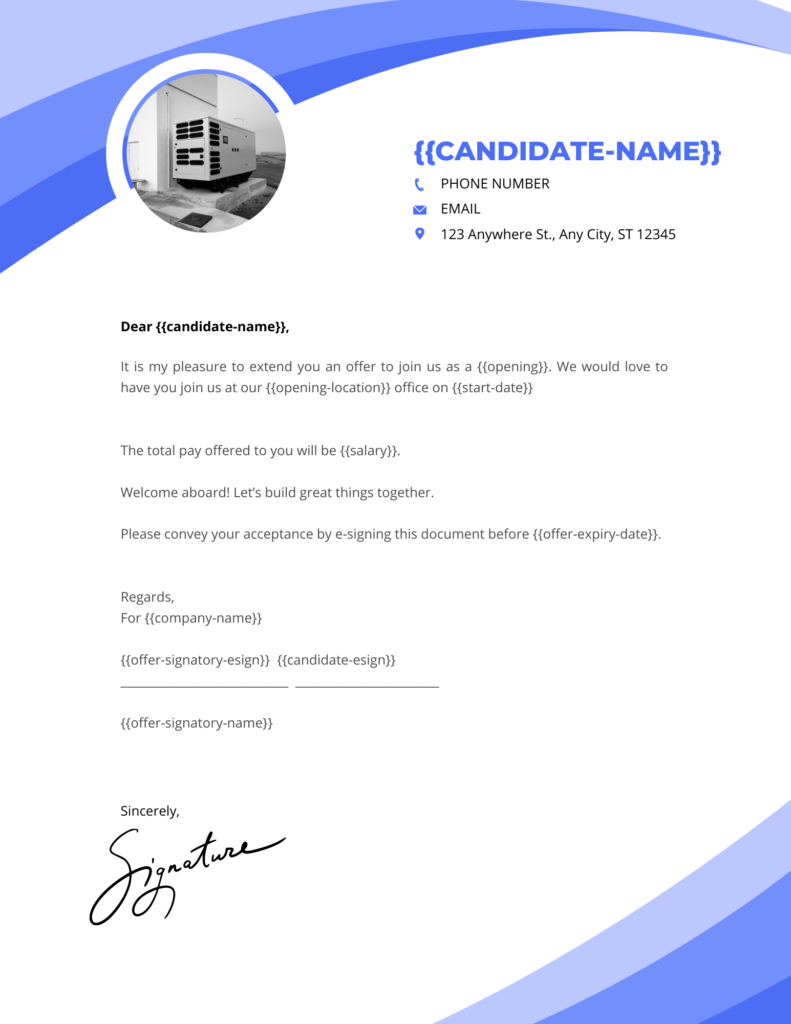Recruiterbox is now Hire, part of the new Trakstar Trifecta alongside Learn and Perform
Learn more about how the Trakstar platform is revolutionizing talent management through integrated, flexible solutions.

Learn more about how the Trakstar platform is revolutionizing talent management through integrated, flexible solutions.

In Hiring Strategy — by Noel Diem

You’ve done the work to find the resumes for your ideal candidates, interviewed them using a hiring team, scored them based on your company culture, and now you need to do your final task: writing an offer letter. When you find the person you want to bring into your company, writing a perfect offer letter can be the difference between getting your ideal candidate and them going somewhere else.
Even if someone has verbally accepted your offer, you need to get everything in writing – for your sake and theirs. A good offer letter is a few things:
When crafting an offer letter, you will likely use a template to start (like one of the ones you can load into Trakstar Hire) and then go on to personalize and fit the offer letter to the candidate and the role. There are many things to keep in mind when crafting both the template and the final offer letter, so it’s important to do some research before you send one out.
The offer letter is one final piece of communication with a prospect before they sign to become an employee. Everything that leads up to this offer matters a little more than the letter itself, but you don’t want to get your offer letter wrong. If you get it wrong, it could undo all your work throughout the hiring process.
If something doesn’t look right, potential employees may have second thoughts about leaving their jobs or picking your offer over someone else’s offer.
A strong foundation for your offer letter is the best place to start. All offer letters should have some of the same components, including:
There are a few other elements that you may want to include in your offer letter, but you don’t have to do so if it doesn’t fit with your company. These include:
Within Trakstar Hire, you can build a template to ensure that you have all of these pieces. Then, you can go on and customize the offer letter to your needs within Hire as well. Use the template and placeholders to automatically pull job information from your job posting, notes, resumes, and more. Save time and eliminate small mistakes that can lead to many problems with this final step to the hiring process.

The time is long gone for boring, by-the-book offer letters. While we suggest you start with a template so that you remember the pertinent details, you should still go off-book if you can! Get your candidate excited about working with your company and for their new role. There is always a little doubt for many new employees, and bringing in some energy is always helpful to erase some of that doubt.
What can you do to make your new hire excited and emotionally attached to their new position?
While yes, offer letters are serious and technically legal documents, you are still allowed to have some personality!

Right before you send your offer letters, there are a few more steps you want to take. These can help you find any errors and ensure everyone is on the same page before the letter goes to the applicant.
Be sure to proof and edit your offer letter! Take a few hours away from it, if you can, and come back with a fresh set of eyes. Have someone on the hiring team look at it as well so that they can fill in any information you may have missed or talk about fun ways to personalize the email.
A good edit is more than just a glance at the grammar: you want to check for consistency, tone, and overall emotional value.
While offer letters aren’t necessarily legal documents, there are terms and conditions in them that the employer is legally bound to in most situations. If you promise things in your offer letter that you either do not intend to deliver on or fail to deliver on, you could find yourself in legal trouble.
Even if you are working from a template, it is best to have your legal team review all offer letters that go outside the norm. Legal should be able to help you draft a template that won’t go against any current laws, but they should review your templates regularly as employment laws change regularly. HR leaders should stay on top of legal changes, but sometimes things will slip through the cracks.
Generally, the higher the position is, and the more salary someone earns, the more likely they are to run it by a lawyer, but that isn’t always the case, so do your due diligence on every offer letter and template.
If you don’t have a legal department, there are some online resources you can use to help understand what the legal implications may be when writing offer letters.
If you want to learn more about the offer management feature or see Trakstar Hire in action, schedule a live demo today!
Remember that getting your new employee is just the beginning! You want to ensure that you welcome them into your organization with a fantastic onboarding experience, you build them up as leaders and employees with consistent training, and you give them valuable feedback as it relates to their original job description and the reason why they were hired.
Trakstar Hire is considered the most user-friendly hiring software on the market. If you’re ready to take your recruiting and hiring to the next level, request a Trakstar Hire demo today.
Trakstar Hire is considered the most user friendly hiring software on the market. If you’re ready to take your recruiting and hiring to the next level, request a Trakstar Hire demo today.
Share this
Applicant Tracking
Candidate Sourcing
Interview Scheduling
Offer Management
Collaborative Hiring
Reports
Careers Site Management
Trakstar is a multi-product HR software provider helping organizations put the people back in people management. Develop and align your staff through better recruiting and applicant tracking, performance management, and learning management. For a more integrated solution to talent management, check out our website and request a live demonstration today.
© 2024 Trakstar